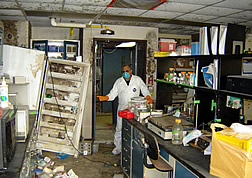This page has been archived and is being provided for reference purposes only. The page is no longer being updated, and therefore, links on the page may be invalid.
|
The Southern Regional Research Center in New Orleans suffered $35 million worth of damages as a result of Hurricane Katrina. After almost two years of renovations, it's again fully operational.
|
|
|
USDA Facility Celebrates Full Recovery from Katrina
By Erin Peabody and Sharon DurhamAugust 10, 2007
NEW ORLEANS, La., Aug. 10—The U.S. Department of Agriculture research facility known for developing wrinkle-free and flame-retardant cotton fabrics was officially rededicated here today, having recovered from damages it sustained two years ago during Hurricane Katrina. The Southern Regional Research Center (SRRC) is part of the Agricultural Research Service (ARS), USDA's chief intramural scientific research agency.
"Opened in 1940, the SRRC is one of four ARS regional research centers for developing new and improved consumer products from agricultural commodities," said Gale Buchanan, USDA Under Secretary for Research, Education and Economics. "Thanks to timely emergency funding from the U.S. Congress and the commitment of agency employees, SRRC became completely operational again in August 2006, a full year earlier than expected."
The 400,000 square-foot research center suffered $35 million in damages from the extensive flooding that followed Katrina.
Among the invited speakers for today's 10 a.m. ceremony were Senators Mary Landrieu and David Vitter, Congressman Bobby Jindal and New Orleans Mayor C. Ray Nagin. In attendance were ARS Administrator Edward B. Knipling, ARS Mid-South Area Director Edgar G. King and SRRC Director John Patrick Jordan.
Following the hurricane, one of ARS' biggest tasks was relocating more than 170 displaced permanent employees and their families across 22 temporary work sites in 12 states, while maintaining critical research projects and progress whenever possible. Another task was completing extensive mold remediation in all of SRRC's laboratories and work spaces.
In addition to achievements in cotton textiles, such as flame-retardant cotton—SRRC was named a National Chemical Historic Landmark in 2004 by the American Chemical Society—the center is committed to seeking solutions to a range of agricultural problems. These include finding ways to protect crops and consumers from toxic fungi, developing environmentally-friendly controls for invasive termites, and extending the shelf life of fresh-cut fruits and vegetables.
The SRRC's research programs also benefit two special segments of the U.S. population: individuals suffering from peanut allergies and those with celiac disease, a chronic condition marked by the inability to digest the proteins in wheat, rye and barley. By screening hundreds of peanut varieties, SRRC researchers have discovered one that naturally lacks a key peanut allergen. Other scientists are developing high-quality wheat- and gluten-free products made from rice and sweet potatoes.

